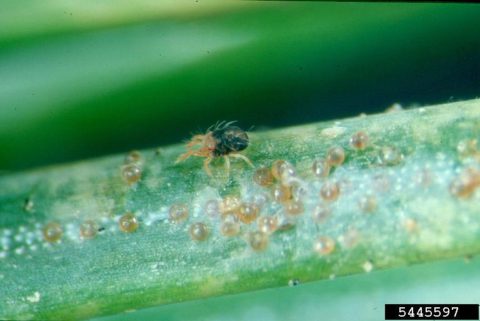
Strong water sprays and reducing drought stress are key to managing spider mites. Photo: Ward Strong, BC Ministry of Forests, Bugwood.org.
We have written a number of blog posts this year about how important water is to the health of your plants. Spider mites are one more example of why plants need enough water.
Our summer’s hot, dry weather is hard on your plants. It is easy for them to get drought stress. Plants under water stress are highly susceptible to pest damage.
You may be seeing damage to some of your plants from spider mites. These common pests damage plants by sucking juice from the underside of leaves. Unfortunately, they are often not noticed until damage becomes apparent.
Identifying spider mites
Spider mites are not insects. They are tiny arachnids (like spiders and ticks) with eight legs and no wings. To the naked eye, they may be invisible or may look like tiny moving dots. They are easily seen with the aid of a magnifying lens. There are a variety of species and colors.
Check the undersides of leaves for mites, their eggs and webbing. You can hold a piece of white paper under a branch and hit the branch sharply. The little dots on the paper that start to walk away are mites.
Host plants
In our area, spider mites most commonly afflict skimmia and dwarf Alberta spruce. They may also affect other plants, such as arborvitae. They are also common on houseplants.
Managing spider mites
In order to successfully control mites, you need to understand their life cycle. Most species overwinter as eggs on host plants. Mites become active in the spring. There may be eight to ten overlapping generations per year.
What you can do to control spider mites
- If you have skimmia or dwarf Alberta spruce, monitor for spider mite damage so management can begin early.
- Keep plants well watered. This is the cornerstone of limiting mite damage.
- Spray the plants (especially the leaf undersides) with a hard, cold water spray several times a day for several days. This will knock many of the mites off.
- Water sprays also raise the humidity around the plants, reducing the mites’ need for moisture and feeding. With enough moisture, natural predators are often able to maintain spider mite populations at harmless levels.
- Mulch around your plants to reduce drought stress.
- Pay special attention to water needs of plants under eaves. Make sure to water the sides of plants facing the house.
- Spider mites have many natural enemies, including predatory mites, lady beetle adults and larvae, lacewing larvae, thrips and minute pirate bugs. These will help limit their numbers, especially when pesticides are not used in the garden.
Consider replacement plant options
You may want to consider replacing your skimmia and dwarf Alberta spruce with plants that are less prone to problems with spider mites.
- Skimmia replacements: Consider sarcococca, mahonia and salal. All of these have a similar size and interest.
- Dwarf Alberta spruce replacements: Unfortunately, there are no plants that will provide a similar shape and form without constant pruning. You may need to try a plant with a different appearance.
Watering resources
One of our recent blog posts listed a number of resources about how, when and why to water effectively.
For more information
- Spider mites, University of California IPM Program.
- Landscape pests-Spider mite, Pacific Northwest Insect Management Handbook.
